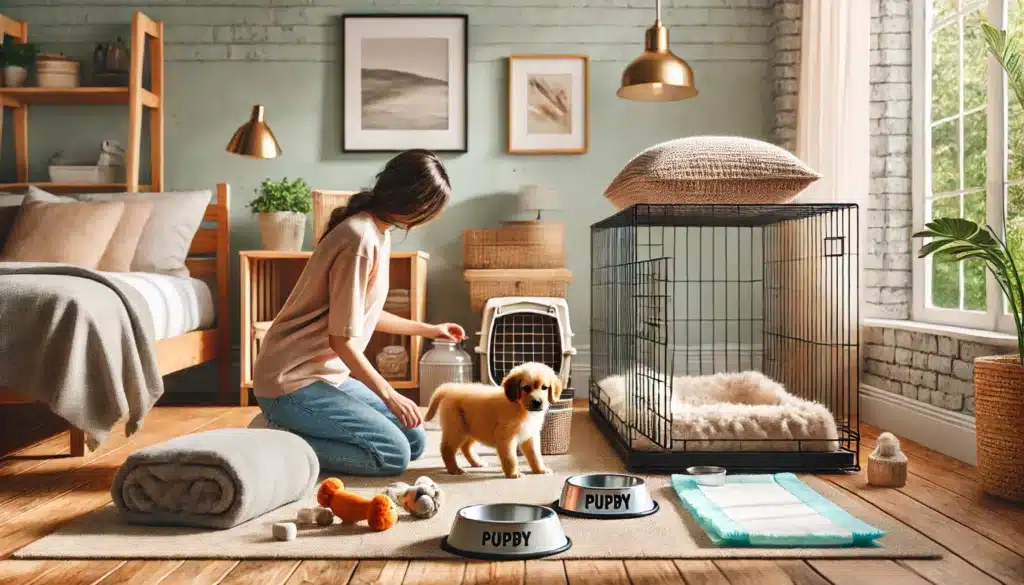Bringing home a new puppy is an exciting — and life-changing — experience. But before the cuddles and playtime begin, it’s essential to make sure your home is safe, structured, and puppy-ready.
Puppies are naturally curious, full of energy, and often unaware of what’s safe or off-limits. Preparing your space in advance helps prevent accidents, supports training, and makes the transition smoother for both of you.
In this article, you’ll learn how to puppy-proof your home, what essentials to have ready, and how to set up an environment that helps your new best friend feel safe, confident, and loved from day one.
Step 1: Puppy-Proof Your Home
Think of it like baby-proofing — but for a little tornado on four legs. Puppies love to explore with their mouth and paws, so removing hazards is priority #1.
🔌 Safety checklist:
- Hide or secure electrical cords (use cord covers or tape)
- Store shoes, socks, and small objects out of reach
- Keep cleaning supplies, medications, and plants locked away
- Use baby gates to block off-limit rooms or stairs
- Anchor heavy items (lamps, floor mirrors) that could fall
- Cover trash bins or store them behind closed doors
- Close toilet lids and remove bathroom rugs (yes, they love chewing those)
Step 2: Set Up a Puppy Zone
Your puppy needs a designated area where they can eat, rest, play, and learn the rules of the home. This also helps with potty training and supervision.
🧸 Ideal puppy space includes:
- A soft bed or mat
- Access to water
- A crate or playpen (for downtime and safety)
- Chew toys and enrichment activities
- Easy-to-clean flooring (or pee pads if house-training)
Place this space in a low-traffic area that still allows your puppy to see and hear you — isolation can cause stress.
Step 3: Gather the Essentials
Having the right supplies on hand makes the first few days go more smoothly.
🛒 New puppy starter kit:
- Collar and ID tag
- Leash and harness
- Puppy food (ask the breeder/shelter what they’re used to)
- Food and water bowls
- Crate (appropriately sized)
- Training treats
- Puppy-safe toys (soft chews, plush, interactive)
- Grooming tools (brush, nail clippers, shampoo)
- Enzyme cleaner for accidents
- Pee pads or grass patch for house training
- Blanket or comfort item with your scent
Optional but helpful:
- Lick mats, slow feeders, puzzle toys
- Baby gates
- Car restraint or crate for travel
- Calming spray (for first nights)
Step 4: Choose a Vet and Schedule the First Visit
Your puppy’s health starts with a solid vet partnership.
- Schedule a check-up within the first 1–2 weeks
- Ask about vaccinations, deworming, and microchipping
- Bring any medical records you received
- Discuss flea, tick, and heartworm prevention
If you haven’t chosen a vet yet, do your research in advance and read reviews.
Step 5: Set a Routine from Day One
Puppies thrive on structure. Start building consistent routines around:
🕐 Basic puppy schedule:
- Wake-up & potty
- Feeding (usually 3–4 small meals/day)
- Potty after meals, naps, and play
- Short play/training sessions
- Nap times throughout the day
- Bedtime at the same hour nightly
A predictable rhythm helps with behavior, potty training, and bonding.
Step 6: Start Gentle Training Early
You don’t need strict obedience on day one, but start laying the foundation:
- Use the puppy’s name often
- Practice recall (“Come!”) with treats
- Reward sitting or calm behavior
- Use positive reinforcement (never punishment)
- Introduce crate time in short, positive sessions
Puppies learn by repetition and association — start shaping good habits early.
Step 7: Socialize Safely
Socialization starts early — but needs to be safe and positive.
- Invite calm, vaccinated dogs to visit
- Introduce common sounds (vacuum, doorbell, traffic)
- Let them meet different people (kids, hats, beards, etc.)
- Use treats to pair new experiences with good feelings
Avoid dog parks or public places until fully vaccinated.
Step 8: Prepare for the First Night
Your puppy’s first night away from littermates can be hard — expect whining or restlessness.
💤 Tips for a better first night:
- Place the crate near your bed
- Use a warm blanket or snuggle toy
- White noise or soft music can help
- Avoid picking them up if they whine — instead, gently reassure
- Be patient: consistency is key for crate success
Step 9: Have a Plan for Potty Training
Accidents will happen — it’s part of the process.
House-training basics:
- Take your puppy out every 1–2 hours at first
- Praise and reward when they go outside
- Interrupt accidents calmly and take them out immediately
- Clean with enzymatic cleaner to remove odor
- Watch for signs: sniffing, circling, or suddenly pausing
Stick to a schedule and be patient — most puppies take a few weeks to months to fully train.
Final Thoughts: Preparation Makes All the Difference
Bringing a puppy into your home is joyful — but also full of challenges. Preparing ahead of time makes the transition easier, smoother, and less stressful for everyone.
By creating a safe space, stocking up on essentials, and establishing routines from the start, you’ll set the foundation for a happy, healthy life together — full of love, learning, and tail wags.
Because the best kind of home is one that says, “You belong here.”







